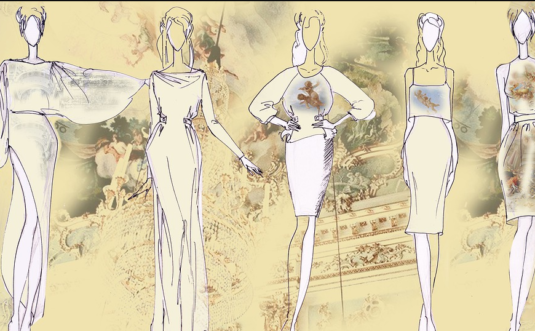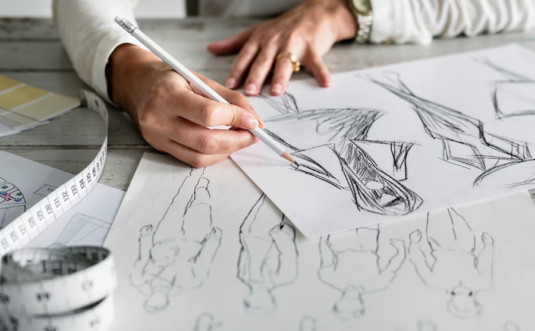Whether you lack formal fashion education, have limited experience as a recent graduate, or are currently a student, entering the fashion world as a beginner can be daunting. However, if your goal is to become a freelance fashion designer, fret not! You’re in luck because we have the step-by-step guide you need, and we won’t waste your time with generic or vague advice like many other industry resources tend to do. So, let’s dive right in and uncover the actual actionable steps you need to take to launch your freelance fashion career, without any unnecessary fluff.
No Barriers, Just Success Stories
No matter where you reside, regardless of your prior experience, and even without an extensive network, you can achieve remarkable success. Take it from Brittany Posey, an aspiring fashion designer who graduated 15 years ago but struggled to secure her big break. Following the advice she received, Brittany landed her first freelance client within a matter of weeks. Now, she feels empowered to pursue her fashion dreams on her own terms as a freelancer.
Similarly, Arya Mishra, a 20-year-old beginner from India without any industry experience or fashion school background, utilized the same advice to secure six clients in just six weeks. Determined to compensate for her lack of formal education, Arya is committed to working diligently to achieve her goals.
Even Eleni Apostolopoulou, a tech designer from Greece with limited “real” industry experience, followed the same advice and now consistently earns $3,000 to $4,000 per month by working part-time on tech packs. Eleni proudly embraces her title as a freelancer, knowing that she started without significant industry exposure. She is amazed by the fact that she is now living the very dreams she once envisioned.
These success stories serve as a testament to the transformative power of determination, hard work, and the right guidance. Regardless of your circumstances, you can overcome obstacles and thrive in the fashion industry. Believe in yourself, seize opportunities, and chase after your dreams with unwavering passion. The journey may be challenging, but the rewards are immeasurable.
Becoming a Freelance Fashion Designer

Embarking on a freelance fashion design journey as a total beginner may seem intimidating, but fear not! The path can be simplified into just six key steps:
- Master an industry skill, such as fashion flats and tech packs, for a solid foundation;
- Choose a niche that aligns with your interests and strengths, and discover that it’s easier than you may think;
- Develop a concise PDF portfolio showcasing self-directed projects to highlight your creativity and skills;
- Determine your freelance rates using clever strategies to ensure fair compensation for your work;
- Uncover hidden gems where you can find freelance clients and build valuable connections;
- Voila! Congratulations, you’re officially a freelance fashion designer, ready to embark on an exciting career in the industry.
Let’s delve into each step to guide you from being a beginner to becoming a successful fashion freelancer.
Step 1: Mastering Fashion Flats and Tech Packs in the Industry
If you haven’t attended fashion school, acquiring these skills will be a DIY endeavor for you. Even if you have a fashion degree, it’s not uncommon to lack proficiency in these areas. Many recent graduates have shared their frustrations about leaving school without understanding the basics of tech packs or fashion flats.
But fret not! You can teach yourself these skills without needing a fashion degree or accumulating hefty student loans. As a total beginner, the two skills that are relatively easier to learn and will kickstart your freelance career are fashion flats and tech packs.
Fashion flats are two-dimensional digital drawings of designs, often created using Adobe Illustrator. On the other hand, tech packs serve as detailed instructions for manufacturers to produce garments—similar to blueprints for a house. Many indie brands and fashion companies require tech packs and fashion flats, making it an excellent entry point for freelance fashion designers.
The best part? I’ve curated a wealth of free resources to help you learn tech packs and fashion flats effectively.
Step 2: Choosing Your Fashion Freelancing Niche
One of the key strategies to achieve success as a fashion freelancer is to choose a niche. In simple terms, it means specializing in offering specific services to a targeted customer base. Trying to do everything for everyone is a common pitfall for beginners fresh out of fashion school, just like Alison, one of our accomplished FAST graduates.
So, how do you go about selecting a niche? If you’re planning to provide flats and/or tech packs, the best approach is to focus on a specific category within the industry. This could entail specializing in denim, lingerie, kidswear, or any other area that ignites your passion.
This strategy works wonders because when a lingerie brand views your portfolio, featuring meticulously crafted lingerie flats, they will immediately recognize your expertise and suitability for the project, regardless of your beginner status. On the contrary, showcasing work or services that span multiple categories like denim, lingerie, and kidswear can appear scattered and turn potential clients away.
Choosing a niche service offers numerous benefits, simplifying your life and accelerating your journey to becoming a successful fashion freelancer. It all starts with creating a portfolio, so let’s delve into this crucial topic.
Step 3: Design a Clean PDF Portfolio
Now that you’ve developed and refined your skills, it’s time to showcase your talent through a clean and visually appealing PDF portfolio. This essential step doesn’t have to be a daunting task – in fact, you can accomplish it in just a single weekend.
Creating a standout portfolio is all about striking the right balance between simplicity and impact. Your portfolio should be clean, well-organized, and easy to navigate, allowing potential clients or employers to quickly grasp your expertise and unique style. Remember, less is often more when it comes to portfolio design.
Take advantage of this opportunity to curate your best work. Select a carefully curated collection of projects that showcase your skills and highlight your creative prowess. Whether it’s fashion flats, tech packs, or other design elements, ensure that each piece reflects your unique artistic vision and attention to detail.
While an entire chapter in my book, “Freelancing in Fashion,” delves into portfolios and provides examples, here are some high-level tips to get you started:
- Focus on 2-4 projects: A handful of well-executed fashion flats or tech packs will suffice;
- Embrace your niche: Reflect the specialization you chose in step 2 (as explained earlier);
- Don’t fret over the platform: A straightforward PDF format works wonders;
- Set a deadline and take action: Commit to a timeline and complete your portfolio promptly.
Regardless of being a total beginner and whether your projects stem from school or self-directed initiatives, you can create an outstanding fashion portfolio that will attract freelance opportunities. Remember, it doesn’t have to be overly complex or extravagant; simplicity can be just as impactful.
Step 4: Discovering Simple Tricks for Freelance Rates
Focus on Learning, Not Just Earning: Setting Your Freelance Fashion Rates
As a beginner in the fashion industry venturing into freelancing, your primary concern should be gaining knowledge and expertise rather than fixating solely on income. However, this doesn’t mean you should arbitrarily select your rates without any consideration.
While I delve into more detailed tips on determining rates in my book, “Freelancing in Fashion,” here’s a quick trick inspired by Ramit Sethi: drop three zeros from your projected annual salary.
First, research the typical entry-level salary for someone without a fashion degree in your location. Then, set your hourly rate by eliminating three zeros, as demonstrated by these examples:
- $20,000/year translates to $20/hour;
- $45,000/year becomes $45/hour.
Step 5: Where to Find Your Ideal Clients

You’ve developed your skills, built an impressive portfolio, and established your freelance rates. Congratulations! You’re no longer a complete beginner. However, the next step in your fashion freelancing journey is to find clients who can benefit from your talents.
While remote freelance fashion jobs may not be readily listed on industry sites like StyleCareers, there are secret places where you can uncover hidden opportunities. Allow me to share two of the easiest methods with you:
| Social Media Platform | Description |
|---|---|
| This platform offers a wealth of potential clients for freelancers who understand how to navigate it effectively. Utilize strategic hashtag techniques to identify brands that align with your expertise. It’s not necessary to create a meticulously curated influencer-worthy grid or post daily; instead, explore other accounts to discover brands seeking freelance services. | |
| Trade Show Listings | Trade shows serve as valuable resources for finding freelance clients. Conduct comprehensive Google searches with your niche in mind to uncover exhibitor listings for relevant trade shows. These events bring together industry professionals, creating excellent networking opportunities for freelancers. |
Step 6: Congratulations, You’re in the Fashion Industry!
You did it! It’s time to celebrate your incredible achievement and revel in your success. Give yourself a well-deserved pat on the back and break out into a joyous happy dance. You have officially entered the captivating world of fashion, and the possibilities before you are endless. Embrace this moment and let your enthusiasm shine as you embark on an exciting journey filled with creativity, growth, and endless opportunities.
Conclusion
Launching a fashion design career as a beginner may feel like a daunting task, but armed with the knowledge and guidance provided in this beginner’s handbook, you can embark on this exciting journey with confidence. From honing your skills and choosing a niche to crafting a standout portfolio and determining your rates, each step is essential in setting the foundation for your success. Focus on continuous learning and embracing opportunities for growth as you navigate the fashion industry. While challenges may arise, perseverance, passion, and a strong work ethic will propel you forward.




